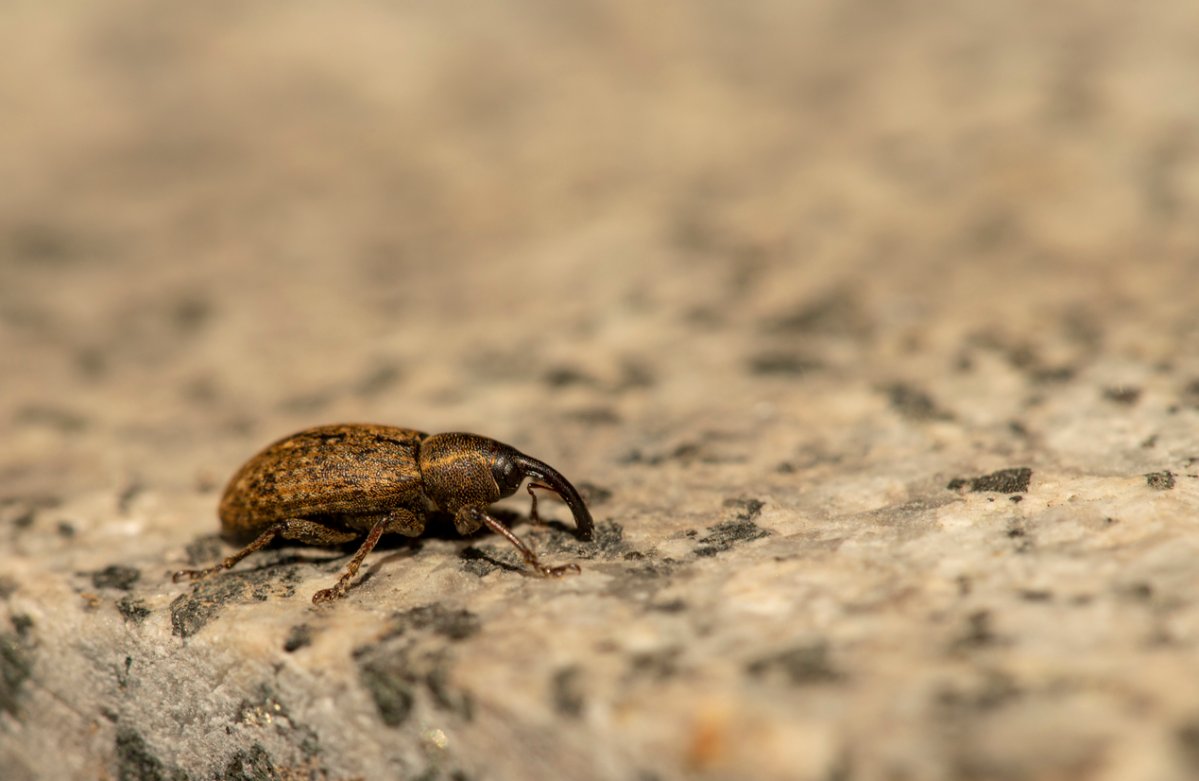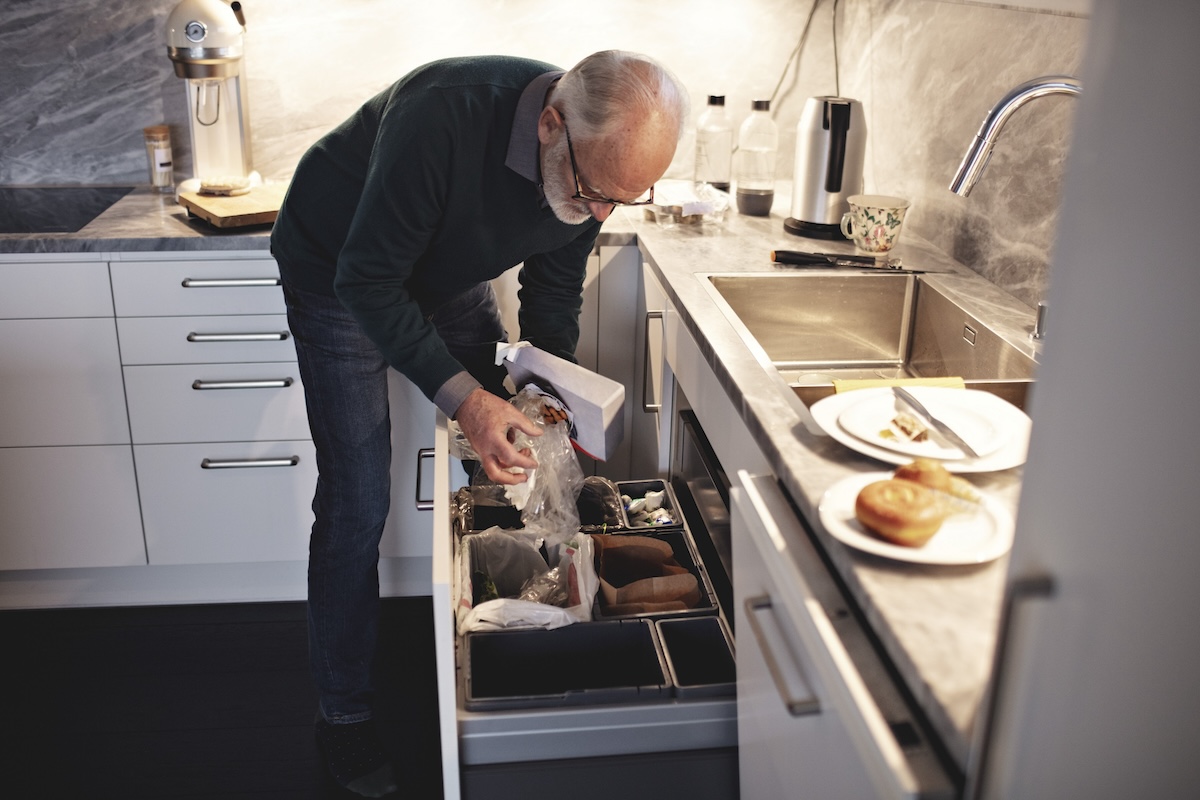

We may earn revenue from the products available on this page and participate in affiliate programs. Learn More ›
No matter how scrupulously you clean your kitchen, tiny weevils still can get through cracks or hijack their way in with groceries like rice or beans. The adults seeking shelter from unfavorable weather can chew into grains and lay eggs, which are virtually invisible until they hatch into larvae that feed on grains.
Once adults, weevils start the cycle again. Though not harmful, weevils are a nuisance and can ruin pantry staples, so follow these helpful strategies for how to get rid of weevils in your cupboards.
What are weevils?

Weevils are part of the beetle family (Curculionidae). Their elongated snouts also lead to their common name of snout bugs. These pantry pests are quite small brownish-black bugs, usually between 1/16 and ¼ inch long. But they can live for up to a year or more, munching on your pantry staples and laying miniscule white eggs.
Among the thousands of weevil species, only a few species are interested in the contents of your pantry. Depending on the species, weevils can infest common pantry items like rice, flour, and corn.
3 Types of Weevils You Might Find in Your Pantry
There are some 60,000 weevil species, and their color and patterns can differ. Many of these are outdoor insects, and some can destroy crops, trees, or vegetables in your garden. The weevils in the house that infest your grocery staples are no more than ¼ inch long, have two antennae and six legs, and feature the telltale long snout. Rice weevils, maize weevils, and granary weevils are the most common in cupboards. Although they are difficult to distinguish from one another without a microscope, each possesses a few distinct characteristics.
Rice Weevils

Rice weevils, aka Sitophilus oryzae, feed on rice and other grains, making the food unsuitable to eat. Characteristics of rice weevils include:
Appearance: 1/16 to ⅛ inch long, with small round indentations in the thorax
Color: Reddish-brown, plus red or yellow markings on wings
Life cycle: 26 days in hot weather
Life span: Up to 2 years, in which a single female can lay up to 400 eggs
Preferred food products: Rice, wheat, barley, oats
Other facts: Adults can fly.
Maize Weevils

Similar to rice weevils, but slightly larger, maize weevils (Sitophilus zeamais) can attack some of the same whole grains, plus a few more. Characteristics include:
Appearance: 1/10 to ⅕ inch long, with dense, with uniform pits or punctures in the thorax
Color: Reddish-brown slightly darker than a rice weevil; has yellow spots on the forewings
Life cycle: 30 to 35 days
Life span: 4 to 8 months, in which they can lay 300 to 400 eggs
Preferred food products: Corn, rice, wheat, pasta, beans (larger grains than flour)
Other facts: Adults can also fly, and those that emerge from corn seeds are larger because the corn provides more food for grubs.
Granary Weevils

Resembling rice weevils the most in appearance and how common they are, granary weevils (Sitophilus granarius) are the largest of the three common pantry weevils. Characteristics include:
Appearance: ⅛ to ¼ inch long, with oval or elongated punctures on thorax
Color: Reddish-brown to black, lacking spots that rice weevils display
Life cycle: 30 to 35 days, longer in cold weather
Life span: 7 to 8 weeks, in which they can lay 50 to 200 eggs
Preferred food products: Whole or broken grains like corn, rye, wheat, and sunflower seeds
Other facts: Adults cannot fly, and are attracted to light.
Causes of Pantry Weevils
Pantry weevils usually enter your home through a purchased product containing eggs or larvae. Adult rice and maize weevils can fly, so they can move from an infested grain to a new area easily inside your home or a food processing plant (and granary weevils can crawl). They might rest between packages while transported or enter packages without airtight seals.
Even if you keep your cupboards and house clean, weevils can enter with new products and then spread, especially under the following conditions:
- Loose packaging or cracks in packaging of flour, grains, and beans.
- Weevil infestations in a neighbor’s apartment.
- Entering a home through cracks and on other insects, especially if in search of shelter or moisture.
Signs You Have Pantry Weevils

Quickly inspecting any susceptible products you purchase when you first open their containers can keep pantry weevils out of your stockpile of grains and flours. When opening the package, look to ensure it has no holes or cracks; also check for small holes in the grains inside. Other signs you have pantry weevils are:
- Visible adults flying or crawling inside a stored grain or in the cupboard.
- Holes in rice or other grains and cereals already in your pantry.
- Clumps or webbing in food, especially in flour and similar powdery products.
- Droppings (known as frass) in the cupboard that look like sawdust.
5 Ways to Get Rid of Weevils
If you find weevils or signs of their damage, don disposable gloves if you don’t want to actually touch any of the pests. Whether you wear gloves or not, weevils won’t cause you any harm. In fact, even if you accidentally ingest a weevil, you don’t need to worry: According to the Singapore Food Agency, they don’t pose health hazards to humans. There are several ways to get rid of weevils in your stored food or pantry, and you likely will need to employ all of the methods below. The sooner you take steps to get rid of infested food and clean the area, the better.
1. Vacuum cupboards and any live weevils you find.
Completely empty your pantry shelves. Remove everything—canned goods, spices, aluminum foil, and whatever else you store in your pantry—so you can be certain to get rid of every weevil. Vacuum the shelves, making sure to get into nooks and crannies that might harbor grains of food or weevils, and then take your vacuum outside to dump the canister or bag.
Wipe down the entire vacuum (canister included) with disinfectant before bringing it back inside.
2. Thoroughly clean your pantry and cupboards.

Wash all shelves and cabinet interiors with a sponge dipped in hot soapy water, white vinegar, or a nontoxic household cleaner; heavy chemicals like bleach or ammonia won’t have any effect on the pests. Some people use nontoxic enzyme cleaners like Nature’s ERADICATOR. Always follow the manufacturer’s recommendations and precautions when using a commercial cleaner where you store food.
If you have shelf liners, you should lift them off and throw them away, since weevils can hide under them. Then clean under where they were placed. Always let cleaned cabinet surfaces dry thoroughly before placing food back onto the shelves.
3. Clean and seal cracks and crevices.
How to get rid of rice weevils and other pantry pests includes thorough attention to where they might hide. While the pantry is empty, take steps to thoroughly clean crevices and cracks. Then seal cracks or other hiding spots, especially if they allow access to food stored in adjoining cabinets. You also might want to check those adjoining cabinets near a crack or crevice to make sure the insects have not already impacted foods stored there. Seal other cracks in your home that you know insects are using as entry points.
4. Throw away impacted foods and clean their containers.

Weevils can live in cardboard packaging, so if boxed products have sealed airtight bags inside, toss the box and keep the bag. (Label the bag with an indelible marker so you’ll know what’s inside.) Do this even for boxed products weevils won’t eat, such as gelatin, because the pests could have entered the box and might emerge later to infest other products.
It’s also possible that weevils have impacted foods in your pantry that show no obvious signs of infestation, so inspect the packaging carefully. Getting rid of all food in the cabinet is the most effective way to ensure the weevils are gone, or you can try freezing potentially affected items as outlined below.
If affected food was in a reusable container, throw out the food and clean the container to get rid of weevils in the pantry for good. You can use soap and hot water or a nontoxic cleanser to disinfect the inside and outside of food storage containers like mason jars and reusable plasticware that could harbor weevils. Let them dry thoroughly before placing food back in them.
5. Apply heat or cold to salvageable foods.
Even sealed pantry goods are subject to weevil infestations, so if you’re concerned, you can put these sealed goods in the freezer for 4 to 7 days to kill any weevils and larvae that might be lurking in them. Vacuum seal and place dry staples, such as rice, beans, pasta, and cereals, in the freezer for 4 to 7 days after purchase before stowing them in cabinets.
Some items won’t withstand freezing—dried herbs, for instance, may lose their zing—in which case you might just want to toss them. Most of the items weevils feed on, however, do fine in the freezer and can be thawed simply by taking them out.
It’s also possible to destroy the pests by heating the food to nearly boiling temperatures, but this could affect future use of the food. In addition, freezing or heating food with large quantities of weevils is not likely to work.
How to Prevent Weevil Infestations

To prevent future problems, inspect your dry goods for weevils before you put anything back in the pantry, and then give them a good once-over the next time you use them. It might take one or two weevil life cycles to completely rid your pantry of the tiny household pests.
It only takes one female weevil to start the cycle all over again. Try the following methods to prevent future weevil infestations as best you can:
- Keep grains and similar staples in sealed glass, metal, or heavy plastic food storage containers. Avoid cardboard, thin plastic, or loose-fitting lids.
- Purchase stacking sets of sealed containers, which can help you maximize storage space and organize your kitchen pantry while sealing out weevils.
- Store nuts and grains in the freezer instead of the pantry if you have the space.
- Only buy enough dry goods to store and use for a few months.
- Store grains in cool, dry spots if possible. Humidity increases how rapidly pests multiply.
- Try placing cloves and bay leaves in and around dry goods, which have scents that weevils hate. The herbs might help deter the pests to help you get rid of weevils naturally.
Final Thoughts
Weevils can enter your home straight from a grocery shelf, so prevention is the key to get rid of weevils in the house. Carefully inspect packages of nuts, seeds, and grains before purchase or as you unpack groceries bought online. If you spot weevils in your pantry staples, remove everything from the pantry, inspect all food and packaging, throw out infested foods and cardboard boxes that might harbor thoroughly clean the cabinets.
Prevent weevils by storing the foods they like in the freezer or in sealed containers. Avoid spraying insecticides in cabinets and pantries where you store food. These chemicals should not come in contact with foodstuffs, and they are not effective or necessary as weevil killers.
FAQ
These tiny beetles like dry foods, such as cereals, grains, seeds, and nuts. Keep in mind that rice weevils, which are common pantry invaders, enjoy lots of grains beyond rice, including barley, wheat, corn, oats, and rye. Weevils thrive in warm—even hot—conditions, and these high temperatures can speed up their life cycle and cause their numbers to multiply rapidly.
Weevils can infest products early in the food chain, such as during harvest or storage. They can also chew through paper and plastic packaging to reach their meals.
Once inside a box, weevils can thrive undetected while working their way through additional plastic or paper barriers. When possible, avoid buying packages with holes or other openings to minimize the risk of bringing the bugs home with you from the grocery store.
The lifespan of a weevil—from egg to adult—can last between 1 and 24 months, depending on the type of weevil and its living environment. In that time, a female weevil can produce as many as 400 to 500 eggs. She perforates seeds or kernels, lays her eggs in the food, and then seals them with a secretion. Her weevil larvae eat the seed or kernel from the inside out, leaving nothing but a husk.
There are many types of weevils, but common pantry weevils go after more than rice and flour. They also like nuts, beans, cereal, corn, and even dried pasta.
If you have a severe weevil infestation, signs of other pests as well, or feel overwhelmed at the prospect of eliminating and controlling weevils, call a pest control professional who knows how to exterminate weevils. They have the tools to determine causes or sources and to best prevent future problems. Many have naturalor botanically derived products for this type of situation.
Pesticides you can buy are not effective against weevils and unsafe in your kitchen storage areas. Your best bet to get rid of them instantly is a trash bag and the cleaning and storage steps mentioned above. A weevil pest control professional might have other strategies to kill weevils, but even pros recommend discarding all infested food as the first step in weevil control.
